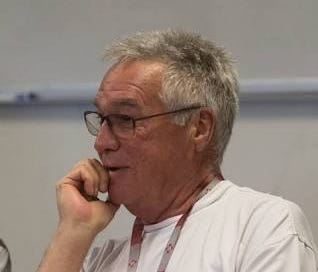Lee K. Abbott, author, friend: Guest post by Mark H. Massé, Memorial, part 2
Reinvention
A special Sunday post: I posted my memoriam as part one of our tribute:
Lee K. Abbott: Author, Teacher, Friend
Lee K. Abbott: October 17, 1947 – April 29, 2019 This memorial will appear in two parts: Mine and Mark H. Massé— his coming soon. On Blindness: A memoriam I read this at Lee K. Abbott’s memorial fall 2019 at the Ohio State University faculty club—by invitation from his friend and colleague Lee Martin.
Here is
“A Pocket Full of Fool’s Gold.”
“Yet, fooled with hope, men favor the deceit.”
(John Dryden, 1631-1700)
At 35, I left a more pragmatic, lucrative career in public relations to pursue life as a full-time writer: first as a journalistic freelancer and later as a book author. I blame The New York Times for giving me hope I could one day write a novel. On April 28, 1985, the Times published my essay “A Hometown Boy Returns” about a bittersweet return to Harrison, N.Y., years after an abrupt and painful departure. The article’s publication heralded a forthcoming bestseller, or so I naively thought.
During the next decade, I would discover the often sobering realities about such great expectations. Writing a novel, like other ambitious quests, is about faith and hope, false promises and often fool’s gold. Most likely, your rewards will be more modest than you imagined. However, if you are fortunate, you will have guides to inspire your journey.
My memorable mentor was Lee K. Abbott, a master teacher and short story writer. From Lee I learned of the “imagined real world” and “willing suspension of disbelief.” I took classes from him when he was on the English faculty at Case Western Reserve University in Cleveland. He was a tall, lean, dark-haired Westerner with a piercing gaze, sardonic wit and hearty laugh. This son of a career soldier was raised in New Mexico, where his magical tales took hold. Because I was older than most of his students, we related more as “grown men” (he being five years and one week older). We spoke of marriage, careers, children, and the mystical game of golf. But that’s all back story to the real narrative: my pursuit of the writing life.
Lee instructed me in the ways of the “liar’s art,” helping to shape my craft and bolster my confidence. By 1990 I had published a couple short stories and completed a young adult novel, The Tough Get Going, while working as a full-time freelancer. When I couldn’t secure publication, Lee offered a figurative pat on the shoulder and a daunting prediction: “It’s usually a third, fourth or fifth novel that is the breakthrough book.”
Despite his own schedule of teaching, writing and speaking at writers conferences across the country, Lee continued to read and critique my work, encouraging me and reminding me of the rigors of authorship. When I felt like giving up, he said:
“Remember, no one can knock on your door and order you to stop writing.” The lesson was clear: It was up to me to endure or surrender those dreams. My quest continued.
In my late thirties, Lee again changed my life by planting the idea of graduate school and a new career path in academia. This remarkable conversation occurred over a nondescript lunch near Lee’s new home in Columbus, after he had become professor and director of the creative writing program at Ohio State University. He told me in no uncertain terms that unless I was that one in a million author who wrote a blockbuster, it was highly unlikely I would ever find the necessary time and focus to develop my craft while balancing a young marriage and burgeoning consulting business. In retrospect, I believe Lee sprinkled fairy dust on me that day. His idea seemed so farfetched yet intriguing. Could I become an educator and serious author on the cusp of 40?
My wife was more than dubious; she flat-out refused to support such fanciful notions. As time passed, the deep fissures in my marriage were revealed, and the center could not hold. That dreary spring of separation, I applied to several MFA programs and was rejected by all but one. A year passed and my divorce was finalized. With Lee’s commiseration, unwavering support (via chats and countless reference letters), and his prediction of better days and better angels ahead, I again applied to both fiction and nonfiction graduate writing programs.
In fall 1992, I set sail for the University of Oregon (UO) to specialize in narrative nonfiction and, hopefully, secure a second career as a writing professor. Some said I was in a post-divorce midlife crisis. What did I hope to gain by going cross-country to become a full-time student? The questions came from family, friends and within. This was a risky venture, considering my age, the rigor of academic life and emotional baggage I carried—a failed marriage and unfulfilled expectations as a novelist. But I was bolstered by Lee’s treasured communiqués, inscribed with his distinctive salutation (“Amigo”) and valediction (“Thrive”).
In 1994, I earned my M.S., Journalism with honors from the University of Oregon, specializing in literary nonfiction. I joined the adjunct faculty and secured enough freelance work to be barely above the federal poverty line. But I had newfound confidence. I dusted off my young adult novel and began reworking it into a family saga. Delamore’s Dreams, which eventually reached 30 chapters and 175,000 words, was about a prodigal son and his estranged father fighting for respect in 1960s metro New York.
After two years as a forty-something adjunct in Oregon, I secured a tenure-track post at Ball State University in 1996, where I taught undergraduate and graduate classes in writing and literary journalism. Now just a three-hour drive from Lee at Ohio State University, I could thank him in person for his unfailing support through the years. We spoke of do-overs in writing and matters of the heart, and, of course, our love of golf.
Unable to secure a mainstream publisher for my “big novel” after years of submissions, rejections, rewriting, resubmissions and more rejections, I went the print-on-demand route. In 2005, Delamore’s Dreams was marketed as a trade paperback. It may have lacked the traditional imprint of legitimacy, but it was nevertheless a published first novel! I felt grateful for completing the quest I had begun 20 years earlier after my essay had appeared in The New York Times.
Lee received an inscribed copy of my novel, and he assured me it was the first of many more to come. Again my indefatigable mentor had been prophetic. As he had predicted, I embraced the academic life, wrote several more books, and found a “better angel,” which he had envisioned years earlier.
In June 2022, I celebrated my 25th wedding anniversary to Mykie, the long-shot beauty and former single mother of three boys, whom I had met as a struggling grad student in Eugene, Oregon. Today, I’m a veteran stepfather, proud grandfather of six, and professor emeritus. By accepting the challenge of a midlife reinvention, I achieved more as an educator and author, husband and father than I ever imagined back in 1992 when I blazed a trail to the Northwest, a journey inspired more than any other by Lee K. Abbott.
I now have 45 years of freelancing, hundreds of articles and a dozen books to my credit, plus more in the pipeline. Yet, given my age (70) and largely unknown writer status, some would advise me to shelve my aspirations for recognition by the literary community. But I persist, a man with a pocket full of fool’s gold, who is heartened by tender mercies—such as when an old pal emailed me after reading Delamore’s Dreams. He said his wife “could not put my book down.”
Though my story has a happy and hopeful ending, it saddens me that Lee died of cancer at age 71 in 2019. One of my profound regrets is that we never got in that round of golf we’d often talked about. But if I can honor my hallowed mentor with a legacy of persistence, perseverance and late-life reinvention as an author, then I will feel fulfilled despite being unable to ever repay a lifelong I.O.U. to Lee K. Abbott.
Mark H. Massé is a longtime freelancer and author of fiction and narrative nonfiction.
Mary adds a craft talk link by Lee at Colgate University. It’s long-ish but entertaining and so worth it, no matter where you are on your journey.
Thank you, Mark.
Love,








What a journey, Mark, and thank you so much for sharing.